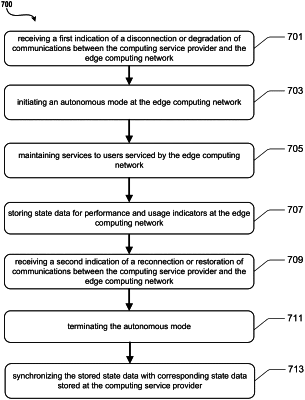| CPC H04L 47/82 (2013.01) [H04L 47/788 (2013.01)] | 20 Claims |

|
1. A method for managing computing resources in a computing network comprising a computing service provider and an edge computing network, the edge computing network comprising computing and storage devices configured to extend computing services of the computing service provider to remote users of the computing service provider, the method comprising:
receiving, by the edge computing network, a first indication of a disconnection or degradation of communications between the computing service provider and the edge computing network;
in response to receiving the first indication of the disconnection or degradation, initiating, by the edge computing network, an autonomous mode at the edge computing network, wherein the autonomous mode enables the edge computing network to continue providing computing and network services to user devices serviced by the edge computing network during the disconnection or degradation of communications between the computing service provider and the edge computing network;
while the edge computing network is operating in the autonomous mode:
maintaining services to users serviced by the edge computing network, wherein the services are provided based on a capacity level determined by the autonomous mode; and
storing state data for performance and usage indicators at the edge computing network, wherein the state data is indicative of local edge computing network state changes while the edge computing network is operated in the autonomous mode and wherein the state data is selectively stored based on a priority determined by the autonomous mode;
receiving a second indication of a reconnection or restoration of communications between the computing service provider and the edge computing network; and
in response to receiving the second indication of the reconnection or restoration of communications between the computing service provider and the edge computing network:
terminating, by the edge computing network, the autonomous mode, and
synchronizing the stored state data with corresponding state data stored at the computing service provider, where coordination of the termination of the autonomous mode and the synchronization of the stored state data enables tracking of services provided to the user devices serviced by the edge computing network while the edge computing network was operating in the autonomous mode.
|